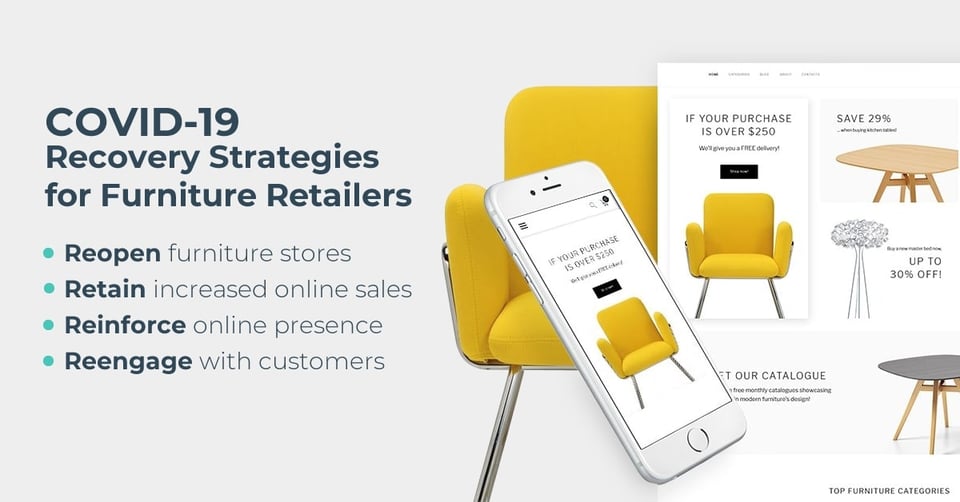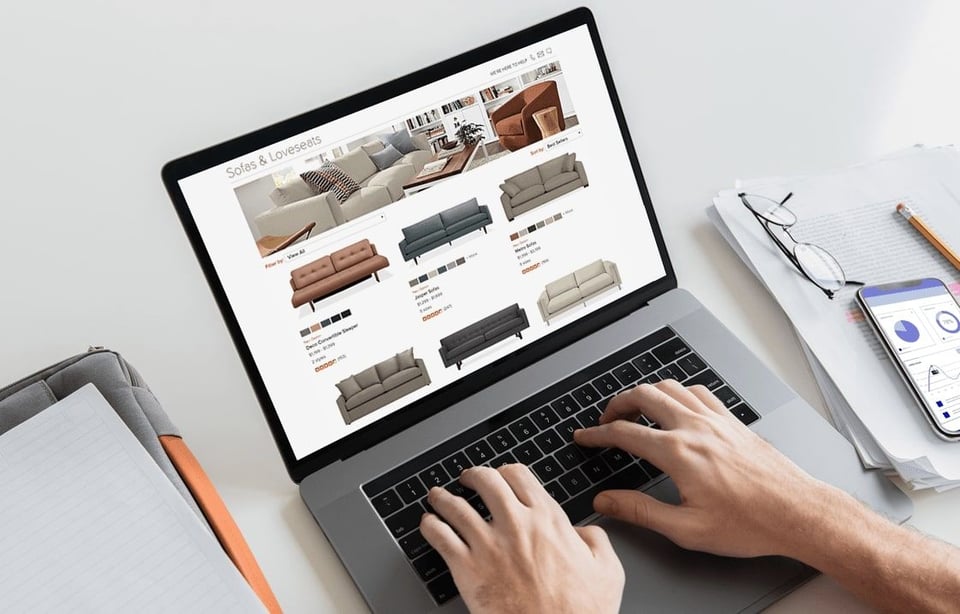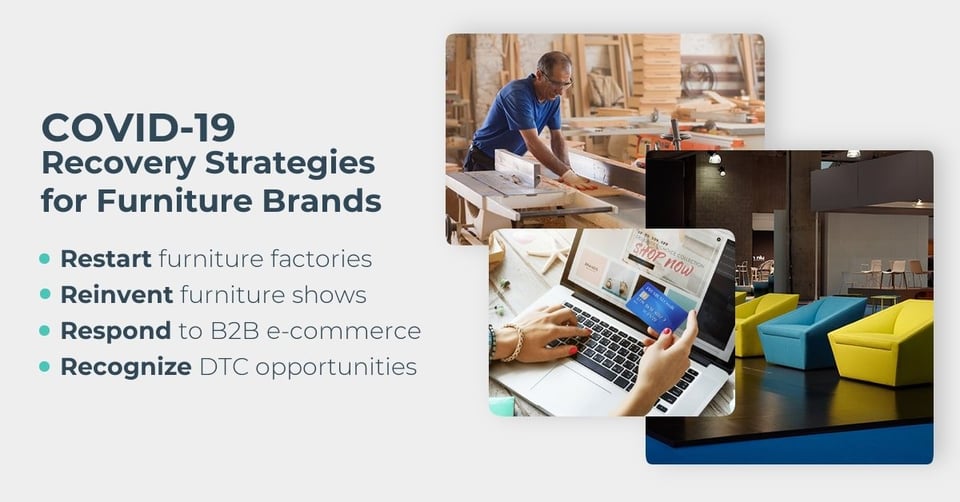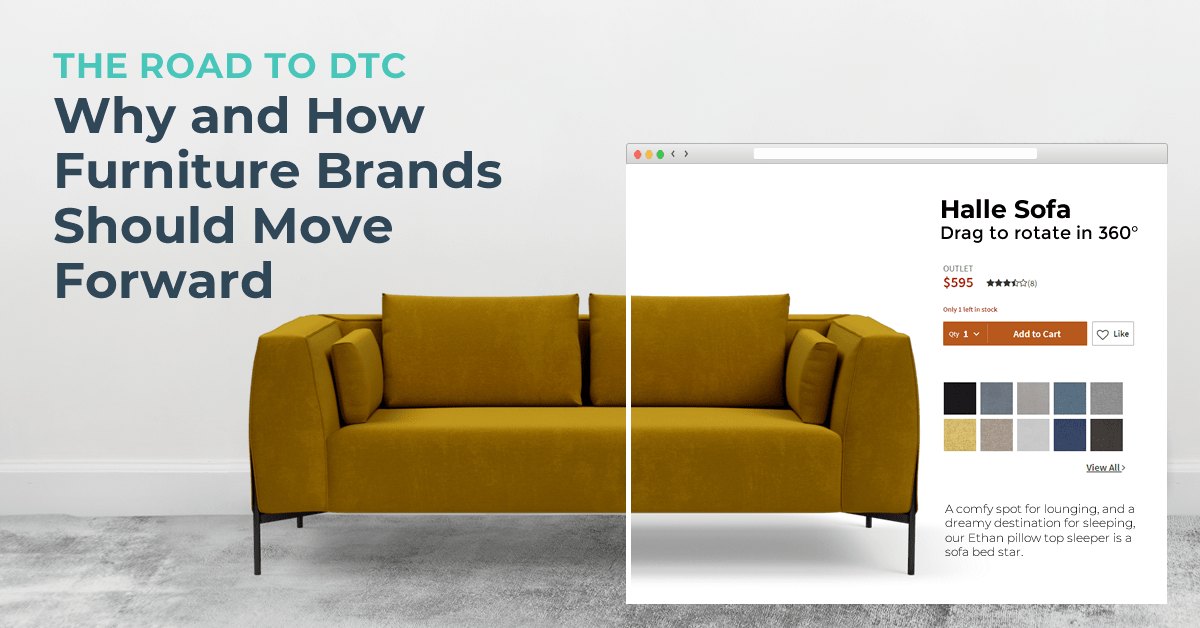With the initial shock of the COVID-19 crisis slowly wearing off, furniture brands and retailers are looking ahead and adapting to meet the demands of a new reality.
The actions that companies take during the recovery period can set the foundation for them to achieve sustained growth and performance after the pandemic is over.
Getting Ready for the Post-Coronavirus World
This isn’t the first time that humanity has faced a pandemic. However, it’s true that there is no modern parallel to compare the coronavirus outbreak with. Both people and businesses were caught off guard by the new reality.
Still, there is always a silver lining. If we look at the SARS epidemic from 2003, it was this same year that was a tipping point for e-commerce in China. People that were stuck indoors had no other choice but to adjust to the new situation and adopt online shopping as the new normal. Fast forward to today, according to eMarketer, e-commerce in China represents around 44% of the total retail sales market and that number is expected to grow to 64% by 2023.
Even though we’re still navigating through uncertainty, we can’t deny that the coronavirus outbreak is a catalyst for change—societal, cultural, economic and corporate. Despite not knowing what the future will look like, one thing’s for sure: the future will be digital.
This once-in-a-generation shift we’re witnessing will have a profound impact on our lives—the way we socialize, communicate, work and shop. There is no doubt that given the complexity of COVID-19, the recovery phase will take some time and it will require careful planning and coordination of actions. Leaders have to chart a new path forward, so they can restore customers’ confidence.
The question is: what are the strategies that will help businesses get back on a trajectory of growth?
Tech-savvy furniture brands and retailers are reallocating resources to projects that will not only help them ride out the storm, but also set the foundation for future growth. Focusing on activities and technologies that will make your business resilient in the future will save you time, money and potential headaches.
Furniture companies need to take the necessary steps to adequately prepare for the recovery. In this blog post, we’re focusing on 4R strategies for proactive planning that will help furniture brands and retailers get ready for the rebound.
COVID-19 Recovery Strategies for Furniture Retailers

1. Reopen furniture stores
As COVID-19 restrictions ease around the world, furniture retailers are starting to reopen their stores. Furniture Today announced that Bassett Galleries, Ethan Allen, Havertys, and HOM Furniture are some of the retailers that have announced their reopening plans.
No one can predict how customers will react and how soon they will go back into the stores. However, retailers have to figure out how to give customers peace of mind and take care of the safety of their customers and employees.
“We are taking a very thoughtful approach to re-opening our stores and stay committed to our people-first approach. We wanted to ensure we had the knowledge and practices in place to navigate any possible need as we reengage with customers in our showrooms. We want our staff members and customers to feel comfortable and safe. That said, we have implemented new practices surrounding engagement and cleaning and in many cases are opening by appointment only.” - Stephanie Kennedy, National Retail Market Manager at Room and Board
What can furniture retailers expect when they open doors for customers? That's a tough question. According to a Morning Consult study conducted at the beginning of April, 24% of consumers said they wouldn't feel comfortable shopping in a mall for more than six months, 16% said they would feel comfortable in the next three months and only 4% said they would in the next month.
Should that discourage retailers? Definitely not. Make sure to prioritize customers’ safety and take the necessary steps to ensure business continuity and stability. Start by adapting your stores and showrooms to meet the social distancing guidelines, place distancing markers at checkout areas, create disinfectant procedures and supply enough face masks and hand sanitizer. Using kiosks where customers can check different products and options is one more strategy to decrease the number of interactions between customers and sales staff. Finally, be patient—when customers feel comfortable once again, they’ll come back to the stores.
2. Retain increased online sales
Even though the furniture industry is facing uncertainties due to the coronavirus outbreak, some companies from the space have witnessed record-breaking online sales.
In our previous blog post, we talked about the huge increase in office furniture sales, (office chairs increased by 104%, and desk sales also went up 89% when compared with the same period last year), plus outdoor furniture sales (UK +1908%, Germany +956%, US +428%, and France +303%), as well as home appliances and bedding (+7% and +12%, respectively).
According to Statista, home decor and furnishing platforms have seen a seven percent global traffic increase between January and March 2020. Overall, websites selling home decor and furniture products online generated 1.7 billion visits in March 2020, up from 1.56 billion global visits in January 2020.
Due to the outbreak, people were forced to stay at home. Many decided to create a pleasant home office setup, while others wanted to refresh their living space. On top of that, people were trying to create outdoor spaces that offer them the freedom and space to enjoy the warm weather in the coming months. Being stuck at home, they had no other choice but to shop online.

Now it’s up to retailers to leverage increased e-commerce sales and keep these levels high after the crisis. How can they do so? By focusing on projects to enhance the online customer experience and create a seamless buying journey.
“Our website, as an important tool supporting our local and national customers, continues to evolve as a result of our own and our customer’s needs and expectations. We will continue in all of our efforts to enhance our customer’s experiences online including many projects that have been in motion for a while. And, we cannot lose sight of the support our customers may need while navigating any online resource. We have seen an increase in customer engagement, both in quantity and length. There is a genuine desire to connect during these times and our teams have always valued the opportunity to speak, chat or email with our customers. We have always known the value of people as part of the overall experience and are fortunate to have amazing staff members that are safely working from home and connecting with our customers.” - Stephanie Kennedy, National Retail Market Manager at Room and Board
3. Reinforce online presence
Now that we’re slowly stepping into the recovery phase, furniture retailers should recognize the shift in customer behavior and consider the technologies that will make their business more resilient in the future.
Furniture businesses that were underestimating the importance of online presence are now paying the price. They were delaying digital transformation up to the point when the coronavirus outbreak happened, and they’ve been caught flat-footed, without the ability to deliver a positive digital experience.
However, there are also furniture retailers that had an omnichannel approach before the pandemic, and they have developed experiences that are meaningful and relevant to consumers both online and offline. These businesses are also the ones that are taking the lead in handling the coronavirus crisis in respectful and helpful ways for customers.
“We continue forward with some key strategic projects related to our e-commerce experience. We are excited to launch our new 3D floor planning tool and look forward to providing our customers with a 360-degree view of our products on our website made possible by our partnership with Cylindo. As well, we have added 1,000s of products to our UPS offer, ensuring shipping of those items that do not require in-home delivery services. Our strategies have always been driven by our customer’s experience and that has not changed during this time. We are committed to keeping them at the center of our decisions.” - Stephanie Kennedy, National Retail Market Manager at Room and Board
Now, where do you start and how do you enhance your online presence? In one of our blog posts, we’ve talked about the anatomy of a perfect furniture e-commerce product page experience. Focus on features that matter to customers and that can help them bridge the online-offline gap, like high-quality visuals, sharp zoom, 360-degree spin, product customization, in-context images, product recommendations and customer reviews. The next step would be introducing more advanced technologies like AR, which gives customers the opportunity to virtually “try-out” furniture, not worrying about bad decisions, and removing a huge weight from their shoulders before the big purchase.
4. Reengage with customers
One of the biggest concerns that retailers have nowadays is how to reengage with customers in a post-coronavirus world. Even though we’ve read so many headlines about the post-COVID-19 customer, and there is no doubt that the outbreak will influence people’s behavior, in the end, one thing that never fails is empathy.
Whether customers decide to show up the first day, tiptoe their way back into stores after a few months, or even if they decide they want to shift to permanently shopping online—your job is to offer them a seamless experience, both online and in-store.
If you’re still not sure how to reengage with your customers here are some tips that can help you start off on the right foot:
- Be transparent with your customers. Announce your plans for reopening and discuss safety measures on social media.
- Communicate frequently. Communication is a two-way street. Don’t just make announcements. Answer questions and reply to messages.
- Consider discounts. During these difficult times, offering discounts can encourage customers to make big-ticket purchases.
- Update your Google information about working hours. Make it easier for customers to find the information they’re looking for.
- Support your local community. Giving back to the community is a way of showing you care. But if you do it, be genuine.
- Listen to customers' feedback and act accordingly. Customers will tell you what they need and what they expect, you just need to listen.
During difficult times we all realize two things: we’re vulnerable and we’re human. Prioritize the safety of your customers and your employees. They’ll be your driving force going forward.
COVID-19 Recovery Strategies for Furniture Brands

1. Restart furniture factories
The two countries that the furniture industry relies on most have been heavily affected by the coronavirus. Many well-known brands have furniture production factories in China, and they’ve experienced difficulties in the production process. On top of this, most high-end leathers come from Italy, creating additional strains on the supply chain. Luckily, things are starting to get back to normal. China is slowly recovering from the crisis, while other countries are also starting to relax lockdown measures.
Century reopened its North Carolina factory on April 20, and in an interview for Business of Home, Alex Shuford III, the CEO of Rock House Farm (a family of brands that includes Century, Hickory Chair and Highland House, among others) talked about the reopening.
The process of reopening requires a lot of reorganizing. Businesses have many new responsibilities including taking steps to ensure social distancing protocols are met and supplying enough masks and hand sanitizer for employees.
“We spent the whole shutdown reconfiguring our facilities—we took steps to ensure proper social distancing protocols, we made thousands of masks and have sanitation stations all over. The basic processes stay the same, but the handoff of materials [and] the way they move through the facility had to change. If there’s a case [of the virus] in the future, we need to be able to provide contact tracing” - Alex Shuford III, CEO of Rock House Farm for Business of Home.
Make sure to put protocols and best practices in place that will enable you to operate safely and efficiently, putting the safety of your employees first.
2. Reinvent furniture shows
Everyone working in the furniture industry is aware of the importance of furniture fairs. This spring, all of them have been canceled or postponed. High Point Market (HPM) and Salone del Mobile were canceled. China International Furniture Fair (CIFF) was initially scheduled for March 18-21, but due to the coronavirus outbreak, it was postponed for June 18-21.
This has caused furniture brands to start thinking of alternatives to furniture shows and how they can present their new collections virtually.
"With High Point Spring Market canceled we executed our own Virtual Market April 22-27. It was a four day event complete with a mixture of on demand content and live sessions using both Zoom and Instagram. On demand features included 360-virtual tour of new product displays, along with video tours of new products with our product teams. Moving forward we believe there is an opportunity for a mix of content to be served up to buyers and customers that combines an in-person experience with a virtual one" - Neil MacKenzie, Director of Marketing at Universal Furniture
Today technology makes it possible to create a series of podcasts or webinars, virtual product tours, 360-view showroom presentations, and more, thus keeping the benefits of furniture shows without jeopardizing buyers’ health.
Even though it’s still too early to say how brands will approach furniture shows in the future, the good news is that during this outbreak, tech-savvy furniture brands showed that they are ready to step out of their comfort zone and use technology in creative ways to create engaging experiences for their customers.
3. Respond to B2B e-commerce
In one of our previous blog posts we’ve talked about the new business buyer. Today’s business buyers are digitally native, and they reflect their consumers' habits to the B2B world. According to the third edition of the “State of the Connected Customer” from Salesforce, 82% of business buyers want the same experience as when they’re buying for themselves.
The COVID-19 outbreak has once again confirmed the importance of an engaging website experience, but it has also opened up this question in B2B e-commerce. In other industries, B2B e-commerce is nothing new. In the furniture industry, things are starting to move in that direction, as we see furniture brands like Knoll, Century, Innovation Living, Mutto, and Montana excel with their online presence.
The coronavirus pandemic will have a substantial impact on the global economy. Businesses all over the world will have to evolve to accommodate this fluid situation. Your website will become your business card, your store, and your showroom. Prioritizing digital merchandising and online presence can future-proof your business and help you stay ahead of the game.
4. Recognize DTC opportunities
The direct-to-consumer (DTC) business model was on brands’ radars way before COVID-19. Over the past few years, brands have increasingly embraced DTC alongside traditional retail. It’s interesting to note that around 50% of the businesses we met at imm Cologne were already testing the waters or exploring the DTC business model.
Three major factors paved the way for widespread adoption of the DTC model:
- Technology - Today, reaching consumers directly is easier and cheaper than ever before.
- The rise of digital-native brands - The success of digital-native brands such as Interior Define, Burrow and Article has shown that the DTC business model has great potential in the furniture industry.
- The shift in consumer expectations - Consumers have high expectations from brands. According to Salesforce:
- 73% of consumers expect to be able to buy directly from a brand as well as from a retailer.
- 76% of consumers expect the same level of engagement when buying from a brand as when buying from a retailer.
- Nearly half of consumers buy at least one product directly from a brand on a regular basis, and 44% expect to buy more products directly from brands in the future.
Shipping products directly to buyers without relying on traditional stores or other middlemen allows DTC companies to sell their products at lower costs than traditional consumer brands. It also allows brands to maintain end-to-end control over the production, marketing and distribution of products. To meet changing customer expectations, brands need to focus on delivering an exceptional omnichannel experience.
Will the coronavirus outbreak encourage furniture brands to go down the DTC road? We’ll soon find out.
What’s Next?
The most important thing that furniture brands and retailers should have in mind to recover from the coronavirus pandemic is to recognize the situation as an opportunity, make the shift and step-up their game.
The recovery strategies you chose today will set a solid foundation for the post-COVID future. Think about which investments are most necessary to create a technological environment that will allow your company to thrive in the new normal and start there.



